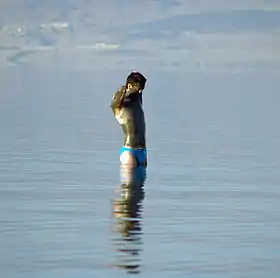Thalassotherapy
Thalassotherapy (from the Greek word thalassa, meaning "sea") is the use of seawater as a form of therapy.[1] It is based on the systematic use of seawater, sea products, and shore climate.[2] Practitioners claim the properties of seawater have beneficial effects upon the pores of the skin.
| Thalassotherapy | |
|---|---|
 A man wearing mud from the Dead Sea. | |
| MeSH | D013790 |
Some claims are made that thalassotherapy was developed in seaside towns in Brittany, France during the 19th century.[3] A particularly prominent practitioner from this era was Dr. Richard Russell,[4][5][6] whose efforts have been credited with playing a role in the populist "sea side mania of the second half of the eighteenth century",[7] although broader social movements were also at play.[8] In Póvoa de Varzim, Portugal, an area believed to have high concentrations of iodine due to kelp forests, and subject to sea fog, the practice is in historical records since 1725 and was started by Benedictine monks; it expanded to farmers shortly after. In the 19th century, heated saltwater public baths opened and became especially popular with higher classes.[9]Others claim that the practice of thalassotherapy is older: "The origins of thermal baths and related treatments can be traced back to remote antiquity. Romans were firm believers in the virtues of thermalism and thalassotherapy.[2]
In thalassotherapy, trace elements of magnesium, potassium, calcium, sodium, and iodide found in seawater are believed to be absorbed through the skin. The effectiveness of this method of therapy is not widely accepted as it has not been proven scientifically. The therapy is applied in various forms, as either showers of warmed seawater, application of marine mud or of algae paste, or the inhalation of sea fog. Spas make hot seawater and provide mud and seaweed wrapping services. This type of therapy is common in the Dead Sea area.
See also
- Balneotherapy, the medical use of bathing
- Halotherapy, the medical use of salts
- Water cure (therapy)
- Dead Sea
- Gurney's Seawater Spa and Thalasso Center, the only one of its kind in the continental US.
- Climatotherapy
- Lydia Sarfati, who introduced seaweed skin treatments to United States
References
- Angus Stevenson, ed. (2007). "Definition of thalassotherapy". Shorter Oxford English Dictionary. 2: N-Z (6th ed.). Oxford: Oxford University Press. p. 3225. ISBN 978-0-19-920687-2. Note: Thalasso therapy is a sub-definition under the listing for Thalasso.
- Charlier, Roger H. and Marie-Claire P. Chaineux. “The Healing Sea: A Sustainable Coastal Ocean Resource: Thalassotherapy.” Journal of Coastal Research, Number 254:838-856. 2009.
- New ager: thalassotherapy, telegraph.co.uk
- Richard Russell, The Oeconomy of Nature in Acute and Chronical Diseases of the Glands (8th edition, John and James Rivington, London, 1755; and James Fletcher, Oxford), accessed 7 December 2009. Full text at Internet Archive (archive.org)
- Russell, Richard (1760). "A Dissertation on the Use of Sea Water in the Diseases of the Glands. Particularly The Scurvy, Jaundice, King's-Evil, Leprosy, and the Glandular Consumption". To which is added a Translation of Dr. Speed's Commentary on SEA WATER. As also An Account of the Nature, Properties, and Uses of all the remarkable Mineral Waters in Great Britain (4th ed.). London: W. Owen. Retrieved 7 December 2009. First published 1750 as De Tabe Glandulari. Full text at Google Books.
- Gray, Fred (2006). Designing the Seaside: Architecture, Society and Nature. London: Reaktion Books. pp. 46–47. ISBN 978-1-86189-274-4. Retrieved 8 December 2009.
- Gray, Fred. (2006), p.46
- Gray, Fred. (2006), p.47
- Projecto para a Construção de Pavilhões na Praia da Póvoa (Maio a Junho de 1924) - Arquivo Municipal da Póvoa de Varzim (2008)